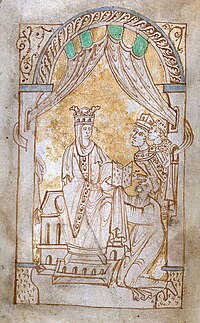| Emma of Normandy | |
|---|---|
 | |
| Queen consort of the English[1] | |
| Tenure |
|
| Queen consort of Denmark | |
| Tenure | 1018 – 12 November 1035 |
| Queen consort of Norway | |
| Tenure | 1028 – 12 November 1035 |
| Born | c. 984[2] Duchy of Normandy |
| Died | 6 March 1052 (aged c. 68) Winchester, Hampshire, England |
| Burial | Old Minster, Winchester. Bones now in Winchester Cathedral |
| Spouses | |
| Issue | |
| House | Normandy |
| Father | Richard the Fearless |
| Mother | Gunnor |
Emma of Normandy (referred to as Ælfgifu in royal documents;[3] c. 984 – 6 March 1052) was a Norman-born noblewoman who became the English, Danish, and Norwegian queen through her marriages to the Anglo-Saxon king Æthelred the Unready and the Danish king Cnut the Great. A daughter of the Norman ruler Richard the Fearless and Gunnor, she was Queen of England during her marriage to King Æthelred from 1002 to 1016, except during a brief interruption in 1013–14 when the Danish king Sweyn Forkbeard occupied the English throne. Æthelred died in 1016, and Emma married Sweyn's son Cnut. As Cnut's wife, she was Queen of England[1] from their marriage in 1017, Queen of Denmark from 1018, and Queen of Norway from 1028 until Cnut died in 1035.
After Cnut's death, Emma continued to participate in politics during the reigns of her sons by each husband, Harthacnut and Edward the Confessor. In 1035 when her second husband Cnut died and was succeeded by their son Harthacnut, who was in Denmark at the time, Emma was designated to act as his regent until his return,[4] which she did in rivalry with Harold Harefoot. Emma is the central figure within the Encomium Emmae Reginae, a critical source for the history of early-11th-century English politics. As Catherine Karkov notes, Emma is one of the most visually represented early medieval queens.[5]
- ^ a b The Anglo-Saxon kings such as Emma's first husband Æthelred the Unready were titled "king of the English". Emma's second husband, Cnut the Great, used the title "king of all England". See Norman Cantor, The Civilisation of the Middle Ages (1995), p. 166.
- ^ Strachan 2004, p. 15.
- ^ Encomium Emmae Reginae, p. 40 digitallibraryindia accessed 21 December 2020
- ^ Philip J. Potter:Gothic Kings of Britain: The Lives of 31 Medieval Rulers, 1016-1399
- ^ Karkov 2004, p. 119.